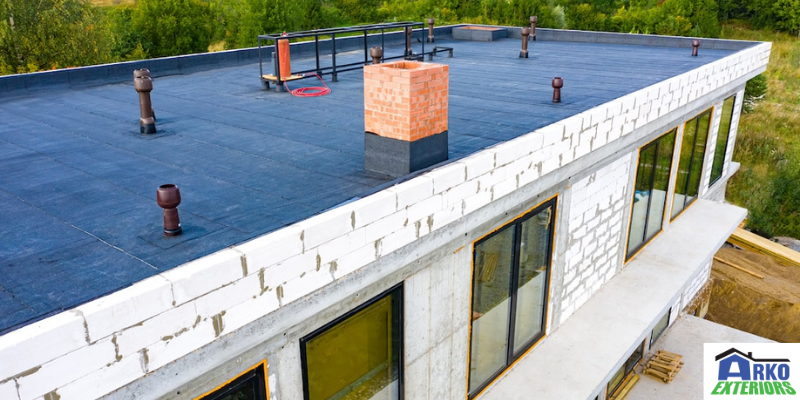Flat roofs are becoming a popular choice for people residing in urban areas. What makes a flat roof a popular choice?
Why Do People Opt For Flat Roofs For Commercial And Residential Buildings?

With the advancement in building and construction technology, flat roofs are not just applicable for industrial buildings but residential and commercial buildings as well. Flat roofs have large spaces that can be transformed into useful areas. You can use the roof for parties, a kid’s play area, gardens, etc.
Flat roofs are reliable, durable and have low construction costs. People who look for simplicity and affordability opt for flat roofs. The most essential advantage of a flat roof is that it requires low maintenance.
What Are The Materials Applicable For Building Flat Roofs?
Here we will discuss the basic flat roof building materials…
#1 Single Ply Membrane:
The single-ply membrane is often referred to as a polymer membrane. You will find the use of polymer membrane in the U.S., Europe and Canada. The polymer membrane is highly reliable, provides rich color shades and is durable. The best feature of the membrane is its resistance to different climatic changes. Usually polymer membrane flat roofs can last for 40 years. With improved technology, there is an increase in the service life expectancy of these roofs. Polymer membrane has high elasticity (about 400%) and offers great resistance to all sorts of weather. It’s affordable and long-lasting.
#2 PVC Membranes:

PVC membranes are often the best option for flat roofs. PVC roofs usually have a single layer of elastic polyvinyl chloride. The PVC material is applicable for flat roofs because of its elasticity and sturdiness. PVC has a high deformation ability. Therefore, you can use it for deformed surfaces. It has resistance to fire, moisture and various climatic conditions. PVC layers are lightweight. They will not exert pressure on the lower floors and walls. Besides, PVC will not require high maintenance or frequent repairing.
#3 Built-Up Roof (BUR):
BUR is known as a built-up roof. Such flat roofs employ a high amount of tar and gravel to form a layer on the roof. This makes the flat roof waterproof and weather resistant. BUR is applicable for residential and commercial flat roofs. It has 15 to 20 years of service life expectancy. BUR offers protection from UV rays and provides durability.
Professional roofing contractors find it easy to install and dismantle BUR roofs.
#4 Modified Bitumen:
This is a comparatively new roofing material applicable for flat roofs. It has great strength and durability. You can get large seamless areas of the flat roof without any hassle. It is easy to install and it’s affordable.
Summary:
Thinking about building a house or building that has a flat roof? Trying to figure out what kind of material(s) to use for your flat roof? Talk with the flat roof experts at Arko Exteriors of Minnesota. For more information, please call Arko Exteriors of Blaine, MN, at 763-434-2756.

